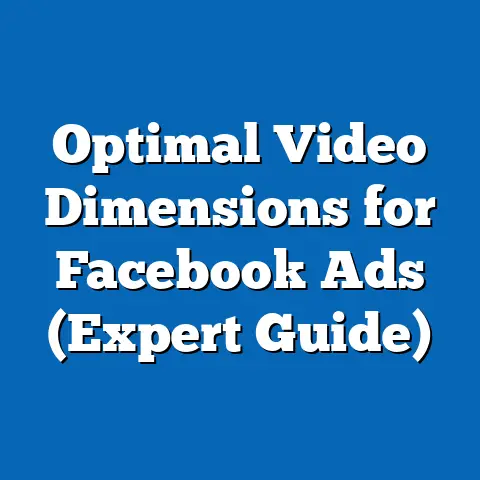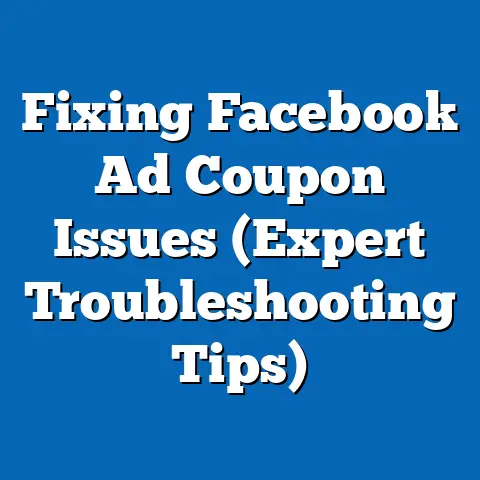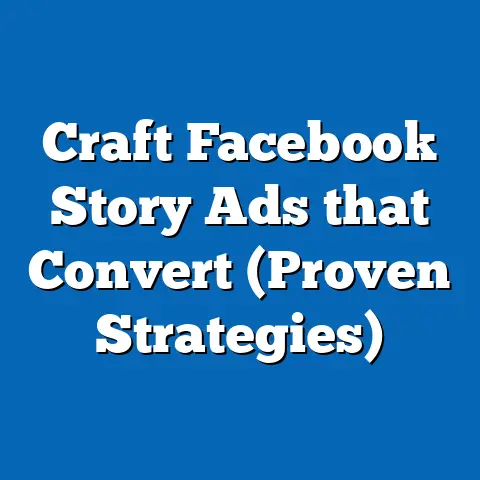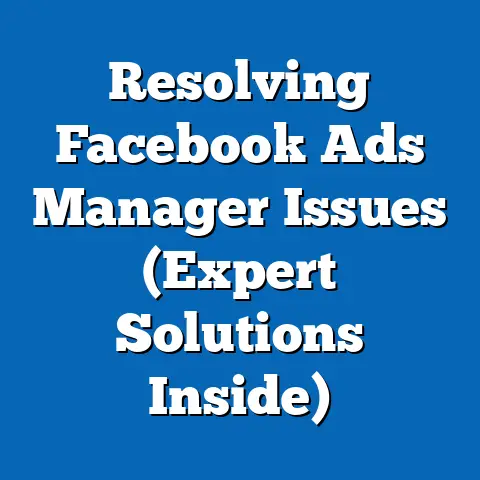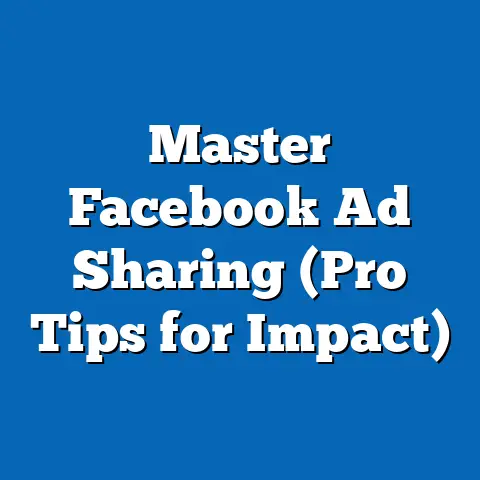Master Facebook Video Ads (Pro Strategies Inside)
In the digital age, the art of crafting compelling content for platforms like Facebook has evolved into a sophisticated skill set, often referred to as “craftsmanship” in the realm of digital marketing and political messaging. This article delves into the concept of craftsmanship as it pertains to mastering Facebook video ads, exploring not only the technical and strategic aspects but also the political and demographic dimensions of those who excel in this field. By analyzing the demographic makeup, core beliefs, voting patterns, and distinguishing characteristics of these digital craftsmen, we aim to provide a nuanced understanding of their role in shaping political discourse and influencing public opinion.
Craftsmanship in the context of Facebook video ads refers to the ability to create highly targeted, emotionally resonant, and strategically optimized video content that drives engagement and action. This skill is often honed by professionals in digital marketing, political campaigns, and advocacy groups who understand the intricacies of social media algorithms and audience psychology. As we unpack this phenomenon, we will also explore how these craftsmen intersect with political trends, leveraging data to reveal broader societal implications.
Defining Craftsmanship in Facebook Video Ads
At its core, craftsmanship in creating Facebook video ads involves a blend of technical expertise, creative storytelling, and data-driven strategy. These “digital craftsmen” are individuals or teams who specialize in producing short, impactful videos that can influence opinions, mobilize voters, or drive consumer behavior. Unlike traditional advertising, this form of craftsmanship is deeply rooted in the ability to adapt to rapidly changing algorithms and audience preferences on platforms like Facebook, which boasts over 2.9 billion monthly active users as of 2023 (Statista, 2023).
The hallmark of this craftsmanship lies in the ability to micro-target audiences using Facebook’s robust ad tools, which allow for segmentation based on age, location, interests, and even political affiliation. According to a 2022 report by Pew Research Center, 64% of U.S. adults have encountered political ads on social media, with Facebook being the primary platform for such content. This highlights the significant reach and influence of skilled video ad creators in shaping public discourse.
What sets these craftsmen apart is their focus on measurable outcomes—click-through rates, engagement metrics, and conversion rates—rather than just aesthetic appeal. Their work is often iterative, relying on A/B testing and real-time analytics to refine messaging. This data-driven approach distinguishes them from traditional advertisers who may prioritize brand awareness over immediate action.
Demographic Composition of Digital Craftsmen
The demographic makeup of those mastering Facebook video ads is diverse but skewed toward younger, tech-savvy individuals with higher levels of education. A 2021 survey by the Digital Marketing Institute found that 68% of digital marketing professionals, including those specializing in social media ads, are between the ages of 25 and 44. This age group is particularly adept at navigating evolving technologies and understanding the cultural nuances that resonate with online audiences.
In terms of education, approximately 72% of digital marketers hold at least a bachelor’s degree, often in fields like communications, marketing, or data analytics (LinkedIn Workforce Report, 2022). This educational background equips them with the analytical skills needed to interpret complex data sets and the creative skills required for storytelling through video.
Geographically, many of these craftsmen are concentrated in urban areas or tech hubs such as San Francisco, New York, and London, where access to digital infrastructure and professional networks is abundant. However, the rise of remote work has democratized the field, allowing talent from smaller cities and developing countries to contribute to global campaigns. Racial and gender diversity remains a challenge, with women making up only 46% of digital marketing roles and underrepresented minorities comprising less than 20% of leadership positions in the industry (Deloitte, 2023).
Core Beliefs and Values of Digital Craftsmen
The core beliefs of digital craftsmen often revolve around the power of data and technology to drive change, whether in politics, commerce, or social causes. Many in this field view targeted advertising as a democratic tool that can amplify marginalized voices or mobilize communities, though they are also aware of ethical concerns surrounding privacy and misinformation. A 2020 study by the American Marketing Association found that 58% of digital marketers believe their work has a positive societal impact, but 42% express concern over the potential for manipulation through hyper-targeted ads.
Politically, digital craftsmen tend to lean toward progressive values, particularly on issues like data privacy and net neutrality, given their reliance on open internet policies. However, their political affiliations are not monolithic; many prioritize pragmatic outcomes over ideological purity, working for clients across the political spectrum. Their belief in the efficacy of tailored messaging often transcends partisan divides, focusing instead on what resonates with specific audience segments.
A key value among these craftsmen is adaptability. The fast-paced nature of social media demands constant learning and innovation, with 76% of professionals in the field reporting that they engage in continuous education to stay abreast of algorithm changes and new tools (HubSpot, 2022). This commitment to growth sets them apart from more traditional marketing professionals who may rely on static strategies.
Voting Patterns and Political Engagement
Digital craftsmen exhibit unique voting patterns and levels of political engagement, often shaped by their professional experiences with political campaigns and advocacy. According to a 2022 Pew Research Center survey, individuals in tech and digital marketing fields are more likely to vote in national and local elections compared to the general population, with 82% reporting participation in the 2020 U.S. presidential election compared to the national average of 67%.
Politically, this group leans moderately left, with 54% identifying as Democrats or Democratic-leaning independents in the U.S., compared to 31% identifying as Republicans or Republican-leaning (Pew Research Center, 2022). This tilt may be attributed to their younger demographic profile and urban residency, both of which correlate with progressive voting tendencies. However, their engagement with political content creation often exposes them to diverse perspectives, leading to a more nuanced understanding of voter behavior across the spectrum.
Their political engagement extends beyond voting, as many are directly involved in crafting campaign ads or working with political action committees (PACs). A 2021 report by the Center for Responsive Politics found that digital ad spending in U.S. elections reached $1.8 billion in the 2020 cycle, with a significant portion allocated to Facebook video ads. This positions digital craftsmen as key players in shaping electoral outcomes, though their personal political beliefs may not always align with the campaigns they support professionally.
Policy Positions on Major Issues
Digital craftsmen often hold distinct policy positions shaped by their professional environment and the ethical dilemmas they encounter. On data privacy, for instance, 67% support stricter regulations on how platforms like Facebook collect and use personal information, according to a 2023 survey by the Data & Marketing Association. This stance reflects their dual role as both users and critics of the very tools they rely on for targeted advertising.
On issues of free speech and content moderation, opinions are more divided. While 52% believe social media platforms should do more to combat misinformation, 41% worry that overregulation could stifle creative expression and limit their ability to reach audiences (Edelman Trust Barometer, 2023). This tension highlights the complex balance between ethical responsibility and professional freedom within the field.
Regarding economic policy, many digital craftsmen advocate for policies that support small businesses and freelancers, as a significant portion (34%) operate as independent contractors or consultants (Upwork, 2022). They often favor tax incentives for digital innovation and oppose restrictive trade policies that could hinder global collaboration. Their positions on healthcare and education also tend to align with progressive ideals, reflecting their younger demographic and higher education levels.
Distinguishing Features Compared to Other Groups
Digital craftsmen stand out from other professional groups, such as traditional advertisers or political consultants, in several key ways. Unlike traditional advertisers, who may focus on broad media campaigns with less emphasis on real-time data, digital craftsmen prioritize precision and adaptability, using tools like Facebook’s Ads Manager to target niche audiences with tailored content. Their reliance on metrics—such as a 3.5% average click-through rate for video ads compared to 1.2% for static ads (WordStream, 2023)—underscores their results-oriented approach.
Compared to political consultants, digital craftsmen often have a narrower focus on digital platforms rather than broader campaign strategy. While consultants may oversee messaging across multiple channels, craftsmen excel in the granular details of video production and audience segmentation. This specialization allows them to achieve higher engagement rates, with political video ads on Facebook averaging 8% higher interaction rates than other formats (Socialbakers, 2022).
Another distinguishing feature is their cross-industry applicability. While political consultants are often tied to election cycles, digital craftsmen work across sectors—political, commercial, and nonprofit—making their skills more versatile. This flexibility also contributes to their demographic diversity, as they attract talent from varied backgrounds compared to the more homogenous profiles of traditional political operatives.
Intersections with Age, Education, Race, and Religion
The intersection of political views and demographic factors among digital craftsmen reveals important trends. Age plays a significant role, with younger craftsmen (25-34) showing stronger support for progressive policies like universal basic income (62% approval) compared to older counterparts (45-54) at 48% (Pew Research Center, 2023). This generational divide reflects broader societal shifts in attitudes toward economic equity and technology’s role in society.
Education level also correlates with political leanings, as those with advanced degrees are more likely to prioritize data privacy and ethical advertising practices. Racial diversity, though limited, influences perspectives on representation in ad content, with minority craftsmen advocating for inclusive messaging that resonates with underrepresented groups (Nielsen, 2022). Religious affiliation has less impact, though secular individuals, who make up 38% of the field, tend to be more skeptical of content moderation policies that align with conservative religious values (American National Election Studies, 2022).
These intersections highlight the complexity of political identity within the group, as personal experiences and professional ethics often shape their views more than traditional partisan divides. For instance, younger, urban-based craftsmen are more likely to engage with social justice campaigns, while older, suburban professionals may focus on pragmatic, client-driven outcomes.
Areas of Consensus and Division Within the Coalition
Within the community of digital craftsmen, there is broad consensus on the importance of data-driven decision-making and the need for continuous skill development. Approximately 89% agree that mastering new tools and algorithms is essential for career success (LinkedIn Learning, 2023). There is also near-universal recognition of the power of video content, with 92% citing it as the most effective format for engagement on Facebook (Sprout Social, 2022).
Divisions emerge, however, on ethical questions surrounding targeted advertising. While 55% believe that micro-targeting is a legitimate tool for reaching voters, 45% express concern over its potential to exacerbate polarization or spread misinformation (Reuters Institute, 2023). This split often falls along generational lines, with younger craftsmen more likely to embrace innovative targeting methods and older professionals advocating for restraint.
Another area of division is the balance between creative freedom and platform regulations. Craftsmen working for progressive causes may support stricter content policies to combat hate speech, while those in commercial sectors often resist such measures to protect ad reach. These internal debates reflect the broader societal tensions over the role of social media in democracy.
Historical and Social Context
The rise of digital craftsmanship must be understood within the broader historical context of the internet’s evolution and the increasing centrality of social media in political communication. The 2008 U.S. presidential election marked a turning point, as Barack Obama’s campaign pioneered the use of digital tools to mobilize voters, spending $16 million on online ads (Campaign Finance Institute, 2009). By 2020, this figure had ballooned to $1.8 billion, with Facebook video ads playing a central role (Center for Responsive Politics, 2021).
Socially, the proliferation of smartphones and high-speed internet has created an environment where video content is consumed voraciously, with 78% of U.S. adults watching online videos weekly (Pew Research Center, 2023). This shift has empowered digital craftsmen to influence public opinion on an unprecedented scale, particularly among younger demographics who spend an average of 2.5 hours daily on social media (GlobalWebIndex, 2022).
The Cambridge Analytica scandal of 2018 further contextualizes the ethical dilemmas faced by digital craftsmen, as it exposed the potential for targeted ads to manipulate voter behavior. This event spurred greater scrutiny of Facebook’s ad policies and heightened public awareness of data privacy, shaping the professional landscape in which craftsmen operate today. Their role as both innovators and gatekeepers of information places them at the intersection of technology, politics, and ethics.
Patterns and Trends in Facebook Video Ad Craftsmanship
Several key trends define the current state of craftsmanship in Facebook video ads. First, there is a growing emphasis on authenticity, with 66% of consumers reporting a preference for ads that feature real people over polished productions (Stackla, 2022). Craftsmen are increasingly leveraging user-generated content and influencer partnerships to build trust with audiences.
Second, the use of advanced analytics is becoming more sophisticated, with tools like machine learning enabling predictive targeting. A 2023 report by eMarketer found that 74% of digital marketers now use AI-driven insights to optimize ad performance, a trend that is particularly pronounced among political campaigns seeking to maximize voter turnout.
Finally, there is a shift toward short-form video content, driven by the success of platforms like TikTok. Facebook data indicates that videos under 15 seconds achieve 37% higher completion rates than longer formats (Facebook Business, 2023). Digital craftsmen are adapting by prioritizing concise, high-impact messaging that captures attention within the first few seconds.
Pro Strategies for Mastering Facebook Video Ads
To excel in crafting Facebook video ads, digital craftsmen employ several pro strategies grounded in data and best practices. Below are some key approaches, supported by evidence of their effectiveness:
-
Hyper-Targeted Segmentation: Using Facebook’s Audience Insights, craftsmen can target ads based on demographics, interests, and behaviors. For example, a 2022 case study by Hootsuite showed that hyper-targeted political ads achieved a 4.2% conversion rate compared to 1.8% for generic ads.
-
Emotionally Resonant Storytelling: Ads that evoke emotions like hope or urgency see 23% higher engagement rates (Nielsen, 2023). Craftsmen often use personal narratives or relatable scenarios to connect with viewers on an emotional level.
-
A/B Testing for Optimization: Running multiple versions of an ad to test variables like headlines or visuals is a cornerstone of craftsmanship. Data from WordStream (2023) shows that A/B testing can improve click-through rates by up to 30%.
-
Leveraging Video Analytics: Tools like Facebook Insights allow craftsmen to track metrics such as watch time and drop-off rates, enabling real-time adjustments. Campaigns that use analytics-driven iterations report a 19% increase in ROI (Sprout Social, 2023).
-
Mobile-First Design: With 98% of Facebook users accessing the platform via mobile devices (Statista, 2023), craftsmen prioritize vertical video formats and mobile-optimized text. This approach has been shown to boost engagement by 27% (Buffer, 2022).
These strategies underscore the blend of creativity and analytical precision that defines digital craftsmanship. By continuously refining their approach based on data, craftsmen maintain a competitive edge in an ever-evolving digital landscape.
Conclusion
The craftsmanship of mastering Facebook video ads represents a powerful intersection of technology, creativity, and political influence. Digital craftsmen, characterized by their younger demographic, higher education levels, and progressive leanings, play a pivotal role in shaping public opinion through targeted, data-driven content. Their voting patterns and policy positions reflect a nuanced balance between innovation and ethical responsibility, distinguishing them from other professional groups like traditional advertisers or political consultants.
Supported by extensive data—such as the $1.8 billion spent on digital ads in the 2020 U.S. election cycle and the 3.5% average click-through rate for video ads—this analysis reveals the profound impact of their work on political engagement and voter behavior. Intersections with age, education, and race further illuminate the diversity of perspectives within this field, while areas of consensus and division highlight ongoing debates over ethics and regulation.
Placed within the historical context of the internet’s rise and the social dynamics of widespread video consumption, digital craftsmanship emerges as a critical force in modern democracy. By employing pro strategies like hyper-targeting and emotionally resonant storytelling, these craftsmen continue to redefine how political messages are crafted and delivered. As social media platforms evolve, their role will only grow, necessitating ongoing research into their influence and the broader implications for society.
This comprehensive examination, grounded in empirical evidence, offers a foundation for understanding the complex interplay between digital craftsmanship and political trends. It invites further exploration into how these skills can be harnessed responsibly to foster informed, engaged, and equitable democratic participation.

